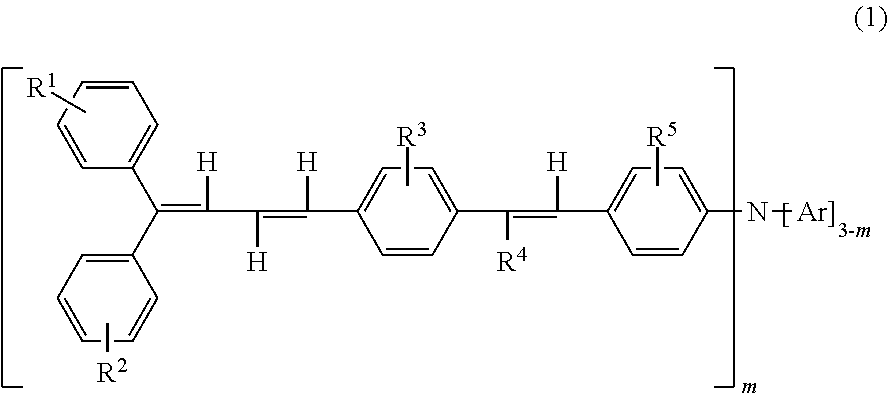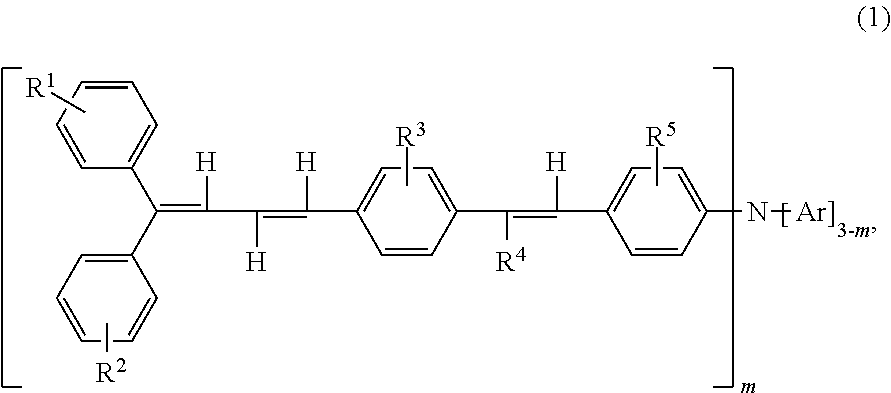Triphenylamine derivative, and charge transport material and electrophotographic photoreceptor using the same
a charge transport material and electrophotographic technology, applied in electrography/magnetography, instruments, organic chemistry, etc., can solve the problems of insufficient carrier mobility of charge transport layers using and cannot be said that conventional low-molecular weight charge transport materials are sufficiently soluble in binder resins and organic solvents, etc., to achieve excellent charge transport materials, good solubility in organic solvents and binder resins, and high carrier mobility
- Summary
- Abstract
- Description
- Claims
- Application Information
AI Technical Summary
Benefits of technology
Problems solved by technology
Method used
Image
Examples
example 1
Synthesis of Compound (2-1) (4-(4′-(4″,4″-diphenyl-1″,3″-butadienyl)styryl)chlorobenzene)
[0094]
[0095]To 64.4 g (0.4 mol) of p-chlorobenzyl chloride, 86.4 g (0.52 mol) of triethyl phosphite was added, followed by heating under reflux for 5 hours. The excess triethyl phosphite was removed under reduced pressure to obtain 108.6 g of a colorless liquid. In 800 ml of tetrahydrofuran, 26.3 g (0.1 mol) of the colorless liquid was dissolved, and further 67.1 g (0.5 mol) of terephthalaldehyde was added thereto. In a nitrogen atmosphere, 12.3 g (0.11 mol) of potassium tert-butoxide was added thereto, followed by stirring for further 3 hours. After extraction with toluene, the extract was washed with water, and then concentrated. Impurities were removed by silica gel column chromatography to obtain 8.0 g of 4-chlorostyrylbenzaldehyde as a white solid. The yield was 33%.
[0096]In 50 ml of tetrahydrofuran, 5.1 g (21 mmol) of the obtained 4-chlorostyrylbenzaldehyde was dissolved, and then 6.6 g (2...
example 2
Synthesis of Compound (2-2) (4-(4′-(4″,4″-bis(4′″-methylphenyl)-1″,3″-butadienyl)styryl)chlorobenzene)
[0100]
[0101]In 50 ml of tetrahydrofuran, 5.1 g (21 mmol) of the 4-chlorostyrylbenzaldehyde obtained by the method of Example 1 was dissolved, and further 7.2 g (20 mmol) of diethyl 3,3-di-(4-dimethylphenyl)propenylphosphonate was added thereto. In a nitrogen atmosphere, 2.5 g (22 mmol) of potassium tert-butoxide was added thereto, followed by stirring for further 3 hours. After extraction with toluene, the extract was washed with water, followed by recrystallization to obtain 7.3 g of a yellow solid (Compound (2-2)). The yield was 82%.
[0102]1H NMR (CDCl3, δ): 2.34 (s, 3H), 2.43 (s, 3H), 6.69 (d, J=15.4 Hz, 1H), 6.82 (d, J=11.1 Hz, 1H), 6.94 (dd, J=11.1, 15.4 Hz, 1H), 6.97 (d, J=16.4 Hz, 1H), 7.04 (d, J=16.4 Hz, 1H), 7.09-7.11 (m, 2H), 7.16-7.24 (m, 6H), 7.28-7.31 (m, 4H), 7.38-7.42 (m, 4H)
[0103]Mass spectrometry ([M]+): found m / z 446.1812 [C32H27Cl]+ (calculated; 446.1796, +3.59 ppm...
example 3
Synthesis of Compound (1-3) (4-(4′-(4″,4″-diphenyl-1″,3″-butadienyl)styryl)phenylbis(4′″-methylphenyl)amine)
[0105]
[0106]In a nitrogen atmosphere, 3.6 g (8.5 mmol) of Compound (2-1) obtained in Example 1, 1.0 g (10.6 mmol) of sodium tert-butoxide, 1.8 g (8.9 mmol) of di-(p-tolyl)amine, 12.4 mg (0.040 mmol) of [PdCl(allyl)]2, and 31.9 mg (0.096 mmol) of 1,1-diphenyl-2-(dicyclohexylphosphino)propene were added to 20 ml of xylene, followed by heating at 100° C. After stirring for 2 hours, water was added thereto, and further toluene was added for extraction to obtain an organic layer. The organic layer was washed with water and then concentrated. Impurities were removed by silica gel column chromatography to obtain 3.5 g of a yellow solid (Compound (1-3)). The yield was 72%.
[0107]1H NMR (CDCl3, δ): 2.31 (s, 6H), 6.70-6.75 (m, 1H), 6.88-7.03 (m, 10H), 7.05-7.07 (m, 4H), 7.23-7.41 (m, 14H), 7.42-7.46 (m, 2H)
[0108]Mass spectrometry ([M]+): found m / z 579.2940[C44H37N]+ (calculated; 579.2921...
PUM
| Property | Measurement | Unit |
|---|---|---|
| thickness | aaaaa | aaaaa |
| temperature | aaaaa | aaaaa |
| thickness | aaaaa | aaaaa |
Abstract
Description
Claims
Application Information
 Login to View More
Login to View More - R&D
- Intellectual Property
- Life Sciences
- Materials
- Tech Scout
- Unparalleled Data Quality
- Higher Quality Content
- 60% Fewer Hallucinations
Browse by: Latest US Patents, China's latest patents, Technical Efficacy Thesaurus, Application Domain, Technology Topic, Popular Technical Reports.
© 2025 PatSnap. All rights reserved.Legal|Privacy policy|Modern Slavery Act Transparency Statement|Sitemap|About US| Contact US: help@patsnap.com



